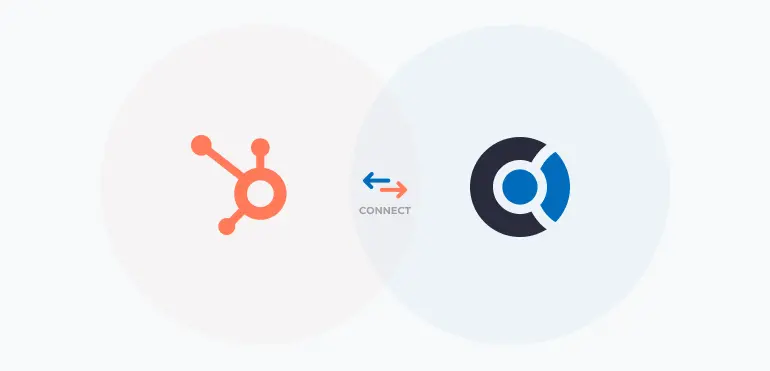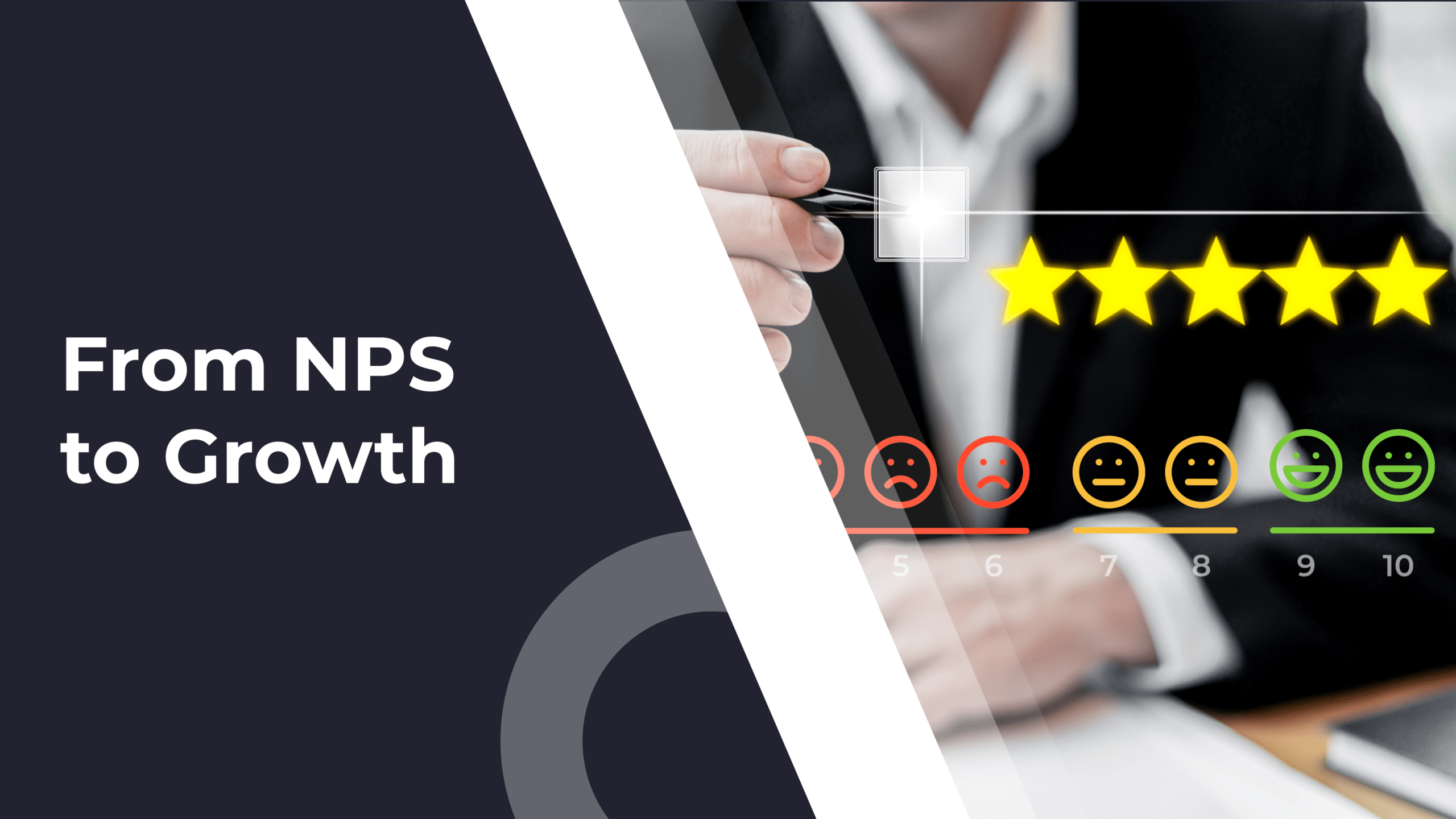Navigating customer success workflows isn’t always easy. But like any treacherous trail, it can be easy if you have a map for your journey.
That’s where a customer success journey map comes in. The document (or collection of documents) defines the lifecycle and highlights customer touchpoints and who should be in charge of each.
We’ll take you through the crucial steps of creating a journey map:
- how to gather the necessary data
- how to analyze and put the data together
- what to do with it when you’re done.
In the end, you’ll have a complete customer journey map to guide your CSMs to the peaks of customer success. Now, let’s get clear on exactly why you should have a customer journey map.
3 Reasons To Create A Customer Success Journey Map
Why create a customer success journey map at all? You could run a customer success program without one. But it’s much harder.
- First, customer success requires the cooperation of multiple departments. Even as a small startup, you’ll have numerous contact points that involve different people getting in touch with a customer (or potential customer) at specific times. If your teams don’t know when they’re expected to reach out to customers, they’ll miss crucial contact points. The optimal window for contact is sometimes very short, and a journey map can make it easier to hit that window.
- Second, the handoffs between departments can be messy. What does each team need to know? Where is data stored? Who’s responsible for making sure the handoff goes well? All of these questions are answered by a journey map. You’ll never have to wonder who can put a customer in touch with the business development team or where to find their support emails. It’s all laid out for maximum efficiency.
- Finally, it makes onboarding new employees easier. Trying to remember who you need to get in touch with during specific onboarding tasks is tricky. And if a customer success rep has to figure it out on their own, it will increase onboarding time and confusion. New CS reps need clarity to do their work efficiently.
Without the proper documentation, organizing the customer success process can be a hassle. Before you start creating that documentation, though, there’s a key step in the process that you’ll need to take:
Step by step guide to creating the customer journey map
Without the proper documentation, organizing the customer success process can be a hassle. Before you start creating that documentation, though, there’s a key step in the process that you’ll need to take
0. Understand What Success Means to Your Customer
This comes before step 1 because it’s so foundational to the process. If you don’t know what success looks like to your customer, you’ll have a hard time creating a successful customer success journey map.
Like most things, this depends on your company, product or service, and customer. Most B2B vendors can define customer success as helping their customers improve their bottom line.
But what about B2C companies? Or companies whose product or service doesn’t have such a clear effect on the earnings statements of their own customers? For these groups, defining success can be more difficult.
In many cases, it’s worth going to your customers and asking them directly. Find out how they define success and how your product or service fits into that definition.
When you understand what you’re trying to help your customer do, you can work backward to find the best steps to take during the customer success journey.
We’ll use our own business as a model here. In our case, one of the important measures of success for our customers is their churn rate (or, for SaaS companies, churn rates). And while our customers have many different facets of success, we’ll focus on a single one to keep things simple here.
1. Identify the Stages of the Customer Lifecycle
The customer lifecycle will be the basis of your customer success journey map. It outlines the different phases that customers go through as they hear about, learn about, purchase, buy, use, maintain, and renew your product or service.
Customer success agents have different responsibilities at different stages of the customer lifecycle, and that’s what we’ll document on the journey map. Here’s an example six-step customer lifecycle that you might use:
1. Interest
2. Purchase
3. Implementation
4. Onboarding
5. Expansion
6. Renewal
Your customer success team is going to have different priorities during the implementation and the renewal phases.
Using a model like this one is a good place to start, but it’s also a good idea to customize it to your particular business. A company that has a very involved setup and customization process, for example, might have several different phases instead of Activation.
Other businesses may choose to use different categories—engagement, consideration, adoption, value actualization, and many others might make sense with your product and your sales/marketing strategies.
We’ll use these six steps as our example:

Write down your own customer lifecycle on a piece of paper and get ready to start making a lot of notes.
2. Assign Groups to Each Phase
Each phase in the customer lifecycle will require action from different groups within your company. If you’re a small startup, it might only be two or three different people—a multinational enterprise could have hundreds.
No matter the size of the groups in your company, though, they will consistently be involved in different phases of the customer lifecycle. For example, marketing will be involved in earlier phases, like demand generation. Sales will be involved in early phases as well, but they may also be involved in later phases where upselling and cross-selling are involved. Customer support isn’t likely to get involved until later.
Your customer success team will likely be involved from around the middle of the process through the end. But, again, it depends on your company and goals.
Here’s how we might assign some of the groups in our company to the lifecycle phases:
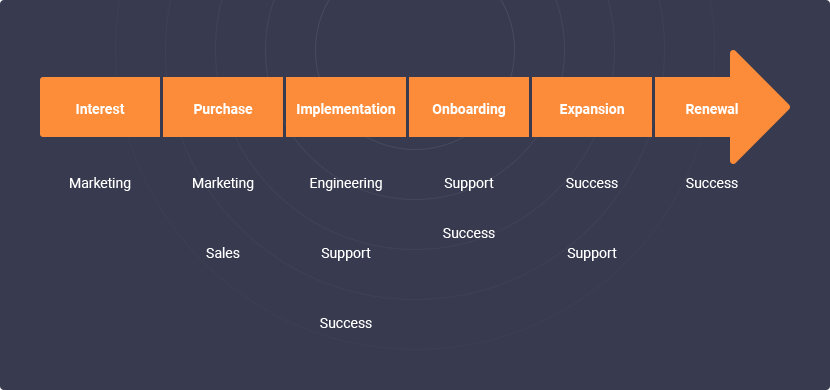
Note that just because a group isn’t listed in a specific phase doesn’t mean they can’t be involved. Just that they aren’t likely to be.
3. Document Handoffs
As different teams and groups get involved in the customer life cycle, they’re likely to need to share data. The sales team will want to know which marketing materials were given to the lead. The implementation team needs to know information that sales collected earlier. Customer support may need specs related to the implementation.
Once groups haven been assigned to each phase of the life cycle, make sure to document the necessary steps in any handoff.
You might use something like Trello, in which case you can reassign a card to another team. If that’s the process, write it down. Who should be tagged on the card? What information should be included in the notes? Is there a standard practice for where data is stored?
All of these questions need to be answered and easily referenced. Don’t assume that any process is obvious enough that it doesn’t need documentation. If nothing else, it will speed the onboarding and training processes.
Let’s take a look at a simplified version of how that might look for our company. We’ll focus on two handoff, the one from sales to marketing and the one from implementation to customer success:
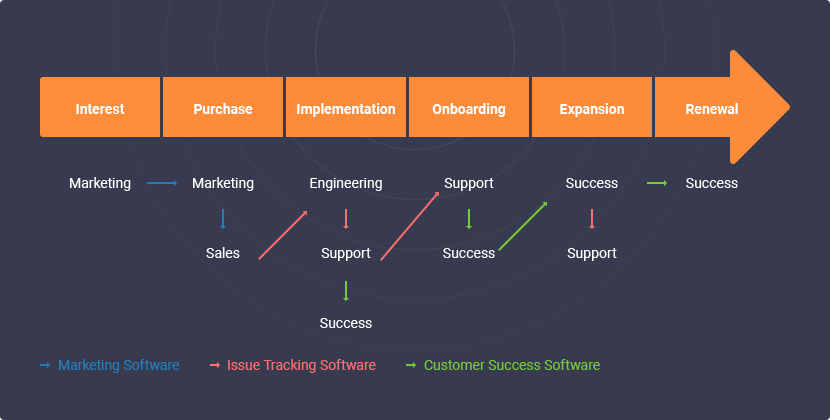
In our customer success journey map, we’ve used colored arrows to indicate the system that needs to be updated. For example, when sales needs to hand information off to the software engineering team, they’ll put it into our issue tracking software.
When our support team gives information to our success team, they’ll use our customer success software.
Of course, you might use a single system for all of this. Or a wider variety of platforms. No matter what you use, make sure that it’s clear how information will travel between groups. There’s not enough room on our example map to include more specific instructions, but that could easily be put in another document.
4. Identify Customer Success Responsibilities
What is your customer success team responsible for? Will your agents provide training? Field support requests? Try to upsell customers? Be in regular communication with their assigned clients?
Customer success means different things to different companies, so it’s important that you define the responsibilities of your group. You should go over these responsibilities during the onboarding process of your team, but it’s still important to have them documented.
(By now, you’re probably thinking that this journey map is going to be packed full of information. It’s important to remember that not every single piece of information needs to be on the map itself. But it should all be stored in the same place and easily accessible.)
As you’ll see in a moment, the responsibilities of your customer success and other teams could change after you see how your system performs. Remember to keep this information updated with the most recent version of responsibilities.
5. Tie Metrics to Lifecycle Phases
Customer success, like any other field, should rely on data to validate and refine methods. With the customer success journey map, you can tie specific metrics to phases in the lifecycle to get even more granular data.
For example, Net Promoter Score is a common customer success metric. In our example, we’ve tied NPS to the onboarding phase, as that’s when we’re most likely to ask our customers to give us a score.
We might also record the number of cross-sells that our customer success agents have. We could associate this with the Expansion phase, where customers are starting to get more value out of the product and might be more open to exploring additional services from our company.
Now that there are metrics measuring the success of our customer success program throughout the lifecycle, we can focus on actions and routines that improve each part of our customer success journey.
Here’s what our metrics might look like:
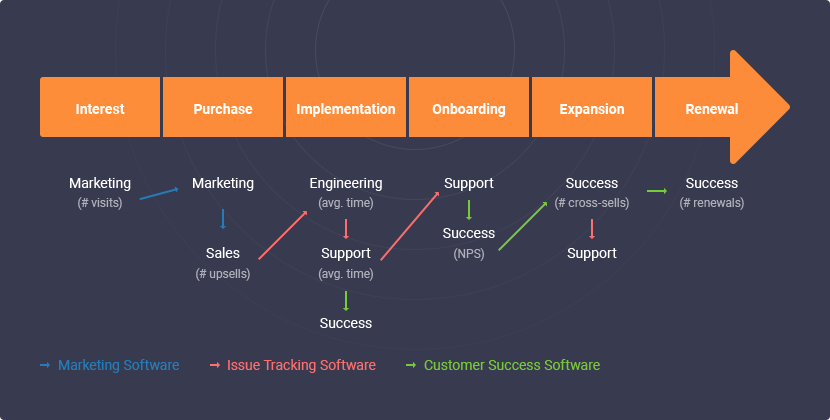
Again, this is a simplified version. We haven’t included our actual goals or current measurements in this map to save space. But it gives teams an idea of what they should be focusing on when they’re working with customers in different stages of the lifecycle.
6. Monitor and Update
Now that you’ve established the phases of the customer cycle, ensured that the right group will always be in contact with your customers at the right time, and identified metrics to measure success, you’re ready to start reaping the rewards.
As with any business process, though, you’ll need to do a lot of maintenance. Even with a solid understanding of your customers’ visions of success and a great plan on how to help them achieve it, you probably aren’t going to get the journey map right on the first try.
Even if you haven’t forgotten a step in the lifecycle or a particular customer success responsibility, you’ll find that some of the steps in the process need tweaking. Or you may need to create additional documentation. There will always be ways to improve the journey map.
And once you’ve collected a few months’ worth of metrics data, you’ll see where your customer service program needs to improve. If you take this information and use it to constantly improve your customer success program, you’ll find that you’re increasingly successful.
Start Small
All of this information can be overwhelming. The journey map itself, along with related information, could fill a small book. And that’s okay. You don’t have to put it all together today.
In fact, it’s best to work through the creation of the map one step at a time. If you don’t have a good definition of what customer success looks like, start there. If you do, but don’t know exactly what your success team needs to do to help, start figuring that out.
If you already have metrics, but don’t yet have them tied to customer lifecycle stages, you can start with that.
No matter where you are in the process, you can start working on (or improving) a customer success journey map. Like customer success itself, it’s an ongoing process that looks toward the future. The most important thing you can do is to get started.

